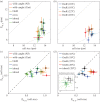Fly wing vein patterns have spatial reproducibility of a single cell
- PMID: 24942847
- PMCID: PMC4208379
- DOI: 10.1098/rsif.2014.0443
Fly wing vein patterns have spatial reproducibility of a single cell
Abstract
Developmental processes in multicellular organisms occur in fluctuating environments and are prone to noise, yet they produce complex patterns with astonishing reproducibility. We measure the left-right and inter-individual precision of bilaterally symmetric fly wings across the natural range of genetic and environmental conditions and find that wing vein patterns are specified with identical spatial precision and are reproducible to within a single-cell width. The early fly embryo operates at a similar degree of reproducibility, suggesting that the overall spatial precision of morphogenesis in Drosophila performs at the single-cell level. Could development be operating at the physical limit of what a biological system can achieve?
Keywords: Drosophila; development; fly wings; pattern formation; precision; symmetry.
© 2014 The Author(s) Published by the Royal Society. All rights reserved.
Figures


 , and shown as a function of the average linear wing cell size of the population. Females are indicated by black circles. In (a), all flies are raised in a controlled environment at 22°C; in (b), identical genetic background (OreR) is used. In both cases, the LR precision of the vein pattern is unaffected and remains at half a cell size (dotted lines have a slopes of 0.5 and 1.0). (c,d) LR versus inter-individual precision under varying genetic (c) and temperature (d) conditions. LR precision (y-axis) and inter-individual (x-axis) precision are measured in units of the linear wing cell size. Flies are on average more symmetric than reproducible (dashed line with a slope of 1 for identity). However, under controlled genetic and environmental conditions (in the most inbred fly lines in (c) and at 18°C in (d)) the left and right wing of a fly are as similar to each other, as they are to the wings of other flies of the same line. Thus, inter-individual and LR patterning precision are equal. Inbreds raised at 28°C (black data in (d)) show no reduction in inter-individual precision. Inset in (d) shows the net difference in the location of landmark 2 between two inbred populations raised at 22°C (light green data in (c)) and at 28°C (black data in (d)), exemplifying that flies with the same genetic makeup raised at two different temperature set-points can have distinct average landmark configurations (green and black crosses indicating error bars), which remain within a single cell and with a single cell and with an LR precision of half a cell diameter. (Online version in colour.)
, and shown as a function of the average linear wing cell size of the population. Females are indicated by black circles. In (a), all flies are raised in a controlled environment at 22°C; in (b), identical genetic background (OreR) is used. In both cases, the LR precision of the vein pattern is unaffected and remains at half a cell size (dotted lines have a slopes of 0.5 and 1.0). (c,d) LR versus inter-individual precision under varying genetic (c) and temperature (d) conditions. LR precision (y-axis) and inter-individual (x-axis) precision are measured in units of the linear wing cell size. Flies are on average more symmetric than reproducible (dashed line with a slope of 1 for identity). However, under controlled genetic and environmental conditions (in the most inbred fly lines in (c) and at 18°C in (d)) the left and right wing of a fly are as similar to each other, as they are to the wings of other flies of the same line. Thus, inter-individual and LR patterning precision are equal. Inbreds raised at 28°C (black data in (d)) show no reduction in inter-individual precision. Inset in (d) shows the net difference in the location of landmark 2 between two inbred populations raised at 22°C (light green data in (c)) and at 28°C (black data in (d)), exemplifying that flies with the same genetic makeup raised at two different temperature set-points can have distinct average landmark configurations (green and black crosses indicating error bars), which remain within a single cell and with a single cell and with an LR precision of half a cell diameter. (Online version in colour.)References
-
- Thompson DAW. 1917. On growth and form. Cambridge, UK: Cambridge University Press.
-
- Cross M, Greenside H. 2009. Pattern formation and dynamics in nonequilibrium systems. New York, NY: Cambridge University Press.
-
- Wigglesworth VB. 1940. Local and general factors in the development of ‘pattern’ in Rhodnius prolixus (hemiptera). J. Exp. Biol. 17, 180.
-
- Lawrence PA. 1973. The development of spatial patterns in the integument of insects. In Developmental systems: insects, vol. 2 (eds Counce SJ, Waddington CH.), pp. 157–209. London, UK: Academic Press.
Publication types
MeSH terms
Grants and funding
LinkOut - more resources
Full Text Sources
Other Literature Sources
Molecular Biology Databases
